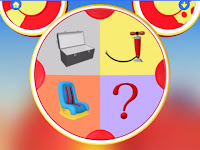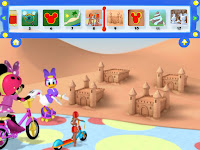With PowerPoint serving as the foundation of
rapid eLearning development for tools like Adobe Captivate and Articulate
Presenter, everyone thinks they can be an eLearning developer. Unfortunately, the development of effective
modules is rarely (probably never) simply putting next buttons on an existing
deck. However, because PowerPoint is the
initial tool for development, there’s no reason a subject matter expert with
interest in developing can’t leverage that passion and do much of the initial
work on the module.
That being said, there are several key
considerations that are essential to spell out before you turn over the keys to
the module. The initial conversation can
make the difference between turning your SME into someone who toils for hours
on a presentation that is of no use to you and turning the SME into your
partner-apprentice who can leverage her understanding of eLearning and create
something that will resemble the final product.
She won’t (and shouldn’t) do everything for the module, but by spending
30 minutes discussing module design, you’ll educate an advocate who will
partner with you to do much of the initial work.
Goals and most important topics
The module should have a goal in mind. Most likely, it will modify behavior or
familiarize the learner with new information.
Here, it is important to know what is most essential to the process as
well as the SME so you can ensure the finished module will accomplish the
goal. This will also be the statement to
which the SME turns to determine if something should be included or omitted
from the module. The goal is as
important for what it does not say as what it does say. You probably aren’t going to familiarize
someone with a new topic to the same degree they will understand it when
they’ve been performing for 5 years, so it probably isn’t as essential to
include all the nuance that a veteran carries in her head.
Keep it short
While completing a SkillSoft course may take
3+ hours, your module probably won’t. A
good rule of thumb is 30 minutes or less.
For very complex or detailed topics, it may take several modules, but
each one should stay under a half an hour.
Cognitive load will max out and the learner won’t be able to take in new
information, so ensure your SME can keep the module short enough to allow the
learner to digest and connect all the new information.
Interactions
The assumption is that you don’t want the
learners to suffer through reading slide after slide of text – or listening to
slide after slide of narration (especially not Text-to-Speech narration). As such, there will need to be several points
of interaction where the learner engages with the material. Your SMEs will vary wildly in the types of
interactions they’ll want to include, so it is your job as the developer to
provide them a menu or have a conversation with them about the types of
interactions you can create. Your
development experience will also have an impact on the types of interactions
that can be created. If you are limited
to the rapid development tools available, you can build multiple choice
assessment questions, hot spots, drag and drop, and a few key others included
with your software. If you are a Flash
developer, the sky’s the limit as to what you can create and include in the
module.
As these interactions are not created within
PowerPoint, you wouldn’t expect the SME to include them in her iteration of the
module. Instead, she’ll include a
placeholder slide in the deck and have a conversation with you (probably before
the PowerPoint is started) to brainstorm the types of interactions that would
best be suited to the situation and content.
From there, you can help guide her to an appropriate understanding of
what will occur on that vacant slide. As
such, she’ll know what should lead up to and what should follow the
interaction.
Because interactions are where the bulk of
the learner’s time as well as your (the developer’s) time will be spent, it is
important that they closely align with the goals of the module as opposed to
being filler. If you were creating a
module to help cafeteria workers understand food preparation safety, your
interactions should focus on that rather than a cashier simulation – regardless
how much fun that may be to develop and play.
Navigation
Along the same lines as interactions,
navigation is an important topic to discuss before module design or PowerPoint
work begins. There are typically three
different types of eLearning navigation: linear, spoke-hub, and hourglass.
Linear navigation includes content presented
in a string of screens. While many will
bash this type of navigation as being restrictive to adult learners, it is the
content that should primarily drive you to this style. If the content requires that A is understood
before progressing to B, non-linear navigation would be foolish. This is the style of navigation that a
PowerPoint presentation follows, so it is the one most SMEs may most
comfortably fall back to when working in PowerPoint. If possible, it should be avoided as the
simplest way to include interaction is to give the learner a choice in where
they go next.
Spoke-Hub navigation includes a menu of
choices with single slide (or linear) sections off of the menu. For example, a module focused on the various
appliances in the kitchen could include a menu of the choices (refrigerator,
stove, oven, microwave, dishwasher) with a few slides detailing each of them
after the learner selected them. Once
that particular section was completed, the learner is returned to the menu
(ideally with some sort of variable flagged to visually indicate that section
was completed). This type of navigation
works well to allow learners the opportunity to explore the content.
Hourglass navigation has learners make
choices that lead to different slides before being returned to a core
slide. A module on interviewing skills
may offer the learner a choice of responses to a question. Each response leads to an appropriate slide
(slides, or possibly even additional decision point), providing feedback on
that particular path, before returning the learner to the next portion of the
interview. This allows the content to be
tailored to the user input, providing a more engaging learning experience.
By understanding the types of navigation
available to her, the SME is then able to create a more customized experience
for the learner that is appropriate to the content. When working with non-linear navigation, it
is often helpful to use PowerPoint section headings and diagrams to keep track
of which slides go where in the experience.
This will be essential to the developer when the PowerPoint is converted
to a module.
Keep the finished product in mind
Although she is using PowerPoint, the SME
will ultimately be creating something that should not look like it was created
in PowerPoint. On the Rapid eLearning Blog, Tom Kuhlman discusses the
importance of changing our presentation template to look like eLearning rather than the bulleted list of PowerPoint
presentations. In order to get your SME
to think of PowerPoint as an authoring tool and not as a bulleted list slide
tool, you may need to help her break out of the box and adjust the master
pages.
Along the same lines, it is important to
establish the visual look and feel up front.
Deciding on heading and body fonts and sizes can save a lot of headache
on the back end if they are understood and incorporated before you have the
deck handed to you. Learners will
attempt to apply logic to your fonts, sizes, and layout. As such, it is important to use them with
intention rather than have them auto-size meaning onto your content.
In addition to the visual text, it is
important to have an agreement on the graphics used in the module. If you are using clipart, you’ll want to
limit yourself to one (or complimentary) style of clipart. Cartoons, icons, and silhouettes don’t mix
well and will make even the best content seem unprofessional and less
valid. If you have access to stock
photography libraries, you can have the SME grab screenshots of watermarked
images from the site in order to decide on the correct images to use. Once consensus is reached, you can download
the actual images without wasting time (or available downloads) by grabbing
images along the way.
Keeping the finished product in mind and
coming to a consensus on a few key design elements will go a long way toward
setting your SME up for success. By
coming to agreement and making a couple of key design decisions at the
beginning of the process, you can empower the SME to do much of the design work
with the developer acting as a consultant, mentor, and guide in the
process. There will be disagreements
along the way, but ironing out those details as you help her understand the
design process will help you create an advocate-apprentice who can help you
more efficiently work through creating modules, especially if it is a client
group with whom you repeatedly work.




